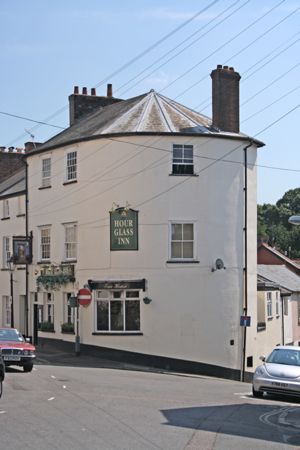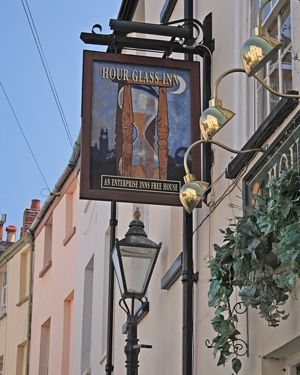
Hour Glass Inn
Page updated 26th April 2014
 One of a diminishing number of local city pubs to survive in Exeter, the Hour Glass Inn is notable for its rounded wedge shape, at the junction of Melbourne Street and Colleton Row. The earliest mention to be found in the local newspapers is in July 1847 when John Stuckes the landlord applied to the Improvement Commission for the path near to the house to be flagged, for improved access. Along with the improved pavement, Stuckes upgraded the house, for in September 1848 he announced an annual dinner for the recent extensive "alterations and improvements, and he flatter himself that the accommodation which his house now affords is not to be equalled by any similar establishment in the city." The advert went on “The very commodious enclosed SKITTLE ALLEY has also been much improved, and gentlemen will now find it adapted for play at all seasons, without their amusement being at all interfered with by the weather.“
One of a diminishing number of local city pubs to survive in Exeter, the Hour Glass Inn is notable for its rounded wedge shape, at the junction of Melbourne Street and Colleton Row. The earliest mention to be found in the local newspapers is in July 1847 when John Stuckes the landlord applied to the Improvement Commission for the path near to the house to be flagged, for improved access. Along with the improved pavement, Stuckes upgraded the house, for in September 1848 he announced an annual dinner for the recent extensive "alterations and improvements, and he flatter himself that the accommodation which his house now affords is not to be equalled by any similar establishment in the city." The advert went on “The very commodious enclosed SKITTLE ALLEY has also been much improved, and gentlemen will now find it adapted for play at all seasons, without their amusement being at all interfered with by the weather.“
John Stuckes moved on to the Black Lions Inn, South Street in March 1849, and the Hour Glass was for sale freehold.
“Situate on the Friars, Exeter, and near the principal thoroughfare from Exeter to Topsham; together also with the PREMISES adjoining thereto, now in the occupation Mr. John Stuckes, the Owner. The Premises are nearly new and in good repair, and consist of a good bar, parlour, dining-room, tap-room, kitchen, 7 bed-rooms, brew-house, wash-house, beer and wine cellars, with other necessary requisite offices, and an enclosed skittle-alley, with very large room over same, which could be easily converted into a very superior Malt-house, or small Tenements, at a very moderate outlay.”
Within a few months, Stuckes was declared bankrupt for the sum of £700. It would appear that he had raised a mortgage on the Hour Glass to fund his move, and in 1851 a sale was ordered by the mortgagees of the house. It was in the occupation of Mr John Parsons Jnr and included the adjoining in the occupation of Mr John Barker along with several unfinished tenements that were to the rear of the inn.
John Parsons had a side line selling dog carts, flys and phaetons; the equivalent of a second hand car dealer. Many adverts appeared from 1853 through 1855, when the license was transferred to Silas Godwin. Parsons still held the freehold, and in 1856 he put the Hour Glass up for sale.
The house went though several licensees up until 1861, when in the July, the license was transferred from the Hour Glass to the London Ale House and the premises were temporarily shut. By 1865 it was open again as a meeting place for the Friends of Labour Loan Society, although the society did not stay, as they transferred to the Oddfellows Arms in 1867. As was common in those days, the house played host to other societies, such as the Labour Loan Society and the Sick and Burial Society; in a time with no welfare state, working people formed beneficial organisations for mutual support. William Daymond died in January 1869, at the age of 39 after a long illness; about a hundred members of the Rational Sick and Burial Society attended his funeral wearing black sashes, as Daymond was a founder member of the society.
A previous owner, John Parsons was declared bankrupt, owing money to two mortgagees of the Hour Glass, and in April 1870 the house was again for sale. Mrs Daymond was still in occupation, and in September 1871, she was unsuccessfully prosecuted for allowing card-playing and gambling on premises. Through this time, several inquests were held for drownings in the river, due to the proximity of the premises to the quay. In 1882, the license transferred, after almost 20 years, from Sophia Daymond to Ernest Phear. By 1900, the house was under the City Brewery, and the license newly transferred to Mr W H Miller.
Unless an event such as a fire, or an interesting crime takes place at a public house, there is often little to mark its progress through time, other than changes of landlords or social events. In the case of the Hour Glass, the visit to Weymouth by 53 customers of the inn was the highpoint of 1923. They left Exeter at 7am for Weymouth, “The Naples of England” according to the report, where they gained a fine view of the Channel Fleet at anchor.
The modern day Hour Glass Inn has had to change with the times, offering food from its restaurant, with a separate bar. It is easy to get to from the quay.
Some landlords of the Hour Glass Inn from the City Council License Committee, and the trade directories are:
1847 - Hour Glass Inn, John Stuckes
1850 - Hour Glass Inn, John Henry Parsons, Hour Glass Arms - White’s
1855 - Hour Glass Inn, John Henry Parson to Silas Godwin
1861 - Hour Glass Inn, William Daymond
1869 - Hour Glass Inn, Sophia Daymond on the death of her husband
1878 - Hour Glass, Mrs Sophia Daymond, 21 Melbourne st, Exeter - White’s
1882 - Hour Glass Inn, Ernest Phear
1885 - Hour Glass Inn, Ernest Phear to Mr Thomas Rowe.
1889 - Hour Glass inn, Thomas Rowe, 21 Melbourne street, Exeter - Kelly’s
1891 - Hour Glass Inn, Mr Thomas Rowe to his widow Mrs Rowe
1900 - Hour Glass Inn, Mr W H Miller
1906 - Hour Glass, Miller, W.H., 21 Melbourne st - Besley's
1915 - W H Miller to M T Browning
1922 - Hour Glass Inn, Mr M T Browning to Mr A Dorothy
1923 - Hour Glass Inn, Alfred Dorothy, 21 Melbourne st. Exeter - Kelly’s
1926 - Hour Glass Inn, Mr Alfred Dorothy to Mr Joseph Coleburne a former Exeter City footballer
1949 - Hour Glass Inn, Mr Joseph Colebourne to Mr Sidney Morgan
1956 - Hour Glass Inn, Rt. Houghton (fully licensed, snacks), 20 & 21 Melbourne st. Tel 58722 - Kelly's
1967 - Hour Glass Inn, 20/21 Melbourne st - Kelly's
2006 - Hour Glass Inn, Mr A Gardiner (Licensee)
│ Top of Page │

